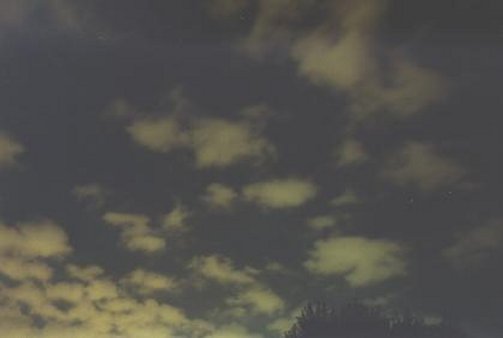SKYLIGHTS

Photo of the Week.. Light clouds flock the nighttime sky.
Astronomy news for the week starting Friday, February 1, 2002.
Happy Birthday. The Star of the Week, born with Aldebaran on
January 30, 1998, is now four years old.
The Moon moves through its waning gibbous phase early in the week,
reaching its third quarter on Monday, Feb. 4 against the stars of
the dim constellation Libra,
after which it will wane through the early portions of the crescent
in the morning sky.
The evening sky is now left to the stars and the planets, which are
beginning to assemble into a crowded display. Mars, nicely visible
in the west in the early evening is still setting around 10 PM.
Though increasing distance between Earth and Mars as the two orbit
the Sun has caused the red planet to dim considerably, it is still
of the first magnitude, and just a bit fainter than the star
Aldebaran in Taurus, which closely shares its color. Climbing ever
higher along the Zodiac, and now in Pisces, its northerly trek will keep it in the evening
sky until summer. While Mars descends toward the west, Saturn and
Jupiter dominate the stage, Saturn crossing the meridian to the
south about 7:30 PM, Jupiter some two hours later. Each holds
court in the two most northerly constellations of the Zodiac,
Saturn in Taurus just north of
the Hyades cluster, Jupiter in
Gemini. The fainter of the two,
the famed ringed planet nearly defines magnitude zero, and is
roughly comparable in brightness to the star Capella in Auriga. Much brighter Jupiter, just over the line into
magnitude -3, outshines all the stars of the sky, even brilliant Sirius in Canis Major. The brightest of all planets, however, is
unfortunately out of sight, Venus having just cleared conjunction
with the Sun. Watch for it as it climbs out of western twilight,
in a month or so joining its planetary compatriots in the evening
sky.
In late evening, Sirius and the Greater Dog, situated down and to
the left of Orion, pass across
the southern sky. Because of its brilliance and southerly
position, Sirius is for us the champion stellar twinkler.
Twinkling is caused by the irregular refraction of starlight as it
passes through Earth's turbulent atmosphere. Refraction, the
bending of light as it passes through a medium of some sort, is
always accompanied by dispersion, or by the breaking of light into
its component colors. Cells of moving air cause starlight to
appear to quickly change its color, much as a diamond in sunlight.
The closer stars are to the horizon, the more air their light must
pass through to reach us, and the greater the twinkling. Stars
overhead may hardly wink, while those just rising and setting
twinkle madly. Because planets are not seen as points, but rather
as disks (through the telescope), their twinkling rather averages
out, and they just stare down at us in serene glory.







